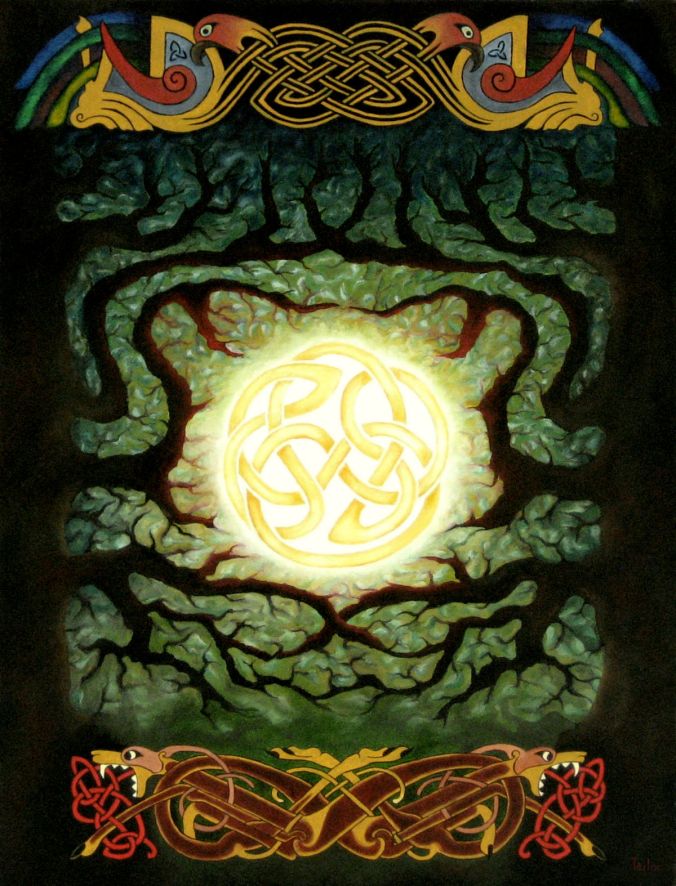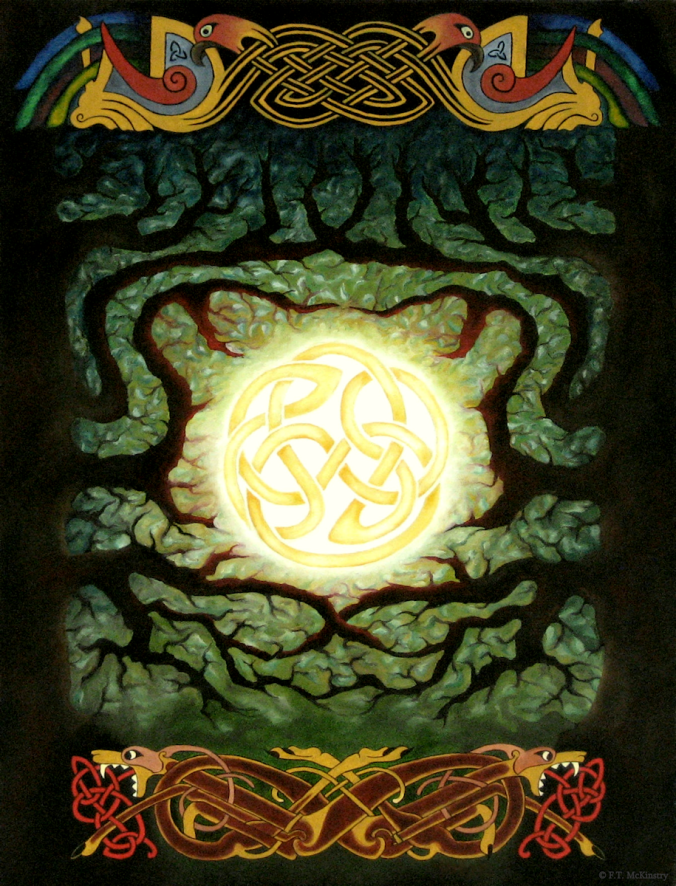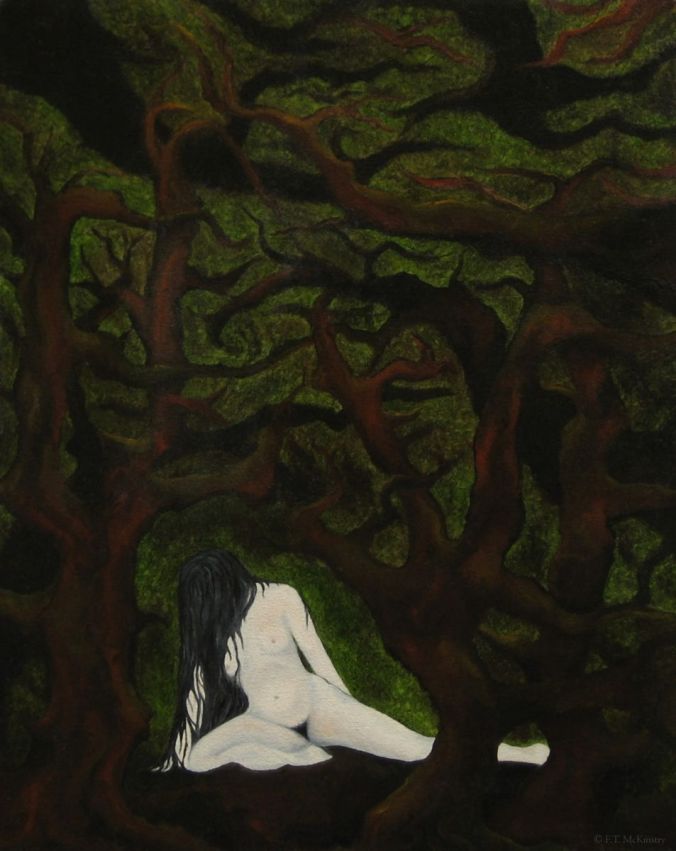Ancient cultures worshiped the sun, moon, rivers, sea and stars as gods. Among other things these forces give life, govern tides and weather, guide travelers on their way and inspire awe, wonder, curiosity and imagination. Sometimes bright, sometimes dark, mysterious and inexorable, these aspects of nature influence every facet of life. They are also capable of destroying it.
In this final installment of Nature as Muse, we’ll delve into how watery forces and celestial luminaries have influenced the fantasy world of Ealiron.
Sun
Thou sun, of this great world both eye and soul. ~ John Milton, Paradise Lost
 The consciousness of Ealiron is symbolized by the sun, the origin of light and life. The entity himself is often called the Source.
The consciousness of Ealiron is symbolized by the sun, the origin of light and life. The entity himself is often called the Source.
In Aenspeak, the wizard’s tongue, the word solsaefil means “Sun Key.” The Sun Key is an architectural construct that uses the crystal focusing towers maintained by the Keepers of the Eye to mark the movement of the sun. The Sun Keys were built centuries ago by the Keepers and integrated into the castles and landscapes where they lived. To this day, the Sun Keys are honored and maintained by the Keepers’ highest ranked wizards.
In the following excerpt, a wizard named Freil explains this to his friend Tansel.
Night had fallen and the moon cast silvery rays into the trees. After a long silence, Freil asked, “Has your great grandfather explained to you about the Muin Waeltower?”
Tansel shifted positions in the saddle, which had grown uncomfortable. “He began to teach me about the stones in the garden. They are different shapes and sizes, and have crystals in them. The beams from the tower shine on them sometimes. The plants gather thickly around some of them, and avoid others. He said things grow and live by the Old One through patterns?”
“Identity patterns, the structural awareness of gods. Their essence rises from the Void to know itself. Has he told you about the Sun Key?”
She craned her face up. “What’s that?”
“Solsaefil, in Aenspeak. The Hall of Muin is designed to use the Waeltower to direct light into celestial patterns. The stones in your garden are part of this. It marks the seasons, the movement of the stars. Tonight, the light beams from the tower will converge on the south side of the hall into a geometric pattern that corresponds to this time of year, just like the oak tree or the chamomile.”
Tansel sat up in excitement. “Is this why the halls are so strange, and the light shines into odd places—crystals in the walls, on the floor?”
“Aye. Every line and point is part of the greater whole.”
“The patterns that form on the full moons, what do they do?”
“They form on the quadrants of the year, each solstice and equinox; that is, when the sun is closest to the earth, or farthest away, or when the day and night are equal in length. This year, the summer solstice happens to align with the Rose Moon. This will open a portal to the Old One.”
“What happens?”
“A gate is projected onto a physical place. What happens there would depend on what you brought with you. At this time of year, daylight reigns; the light of the sun is at its peak. This corresponds to the maternal aspect of the Old One, she who nurtures, grows, gives birth. Gardens bloom and flourish. So where that energy is within you, you might see something. Or you might not.” ~ The Winged Hunter
Moon
The moon gazed on my midnight labours, while, with unrelaxed and breathless eagerness, I pursued nature to her hiding-places. ~ Mary Shelley, Frankenstein
 The moon emanates peace and mystery like a fragrance . It is a powerful force governing life cycles through the rhythmic rise and fall of the liquid universe. In Ealiron, the moon is a reflection of the Old One, a primeval goddess of birth, life and transformation. The phases of the moon represent the nature of the goddess herself.
The moon emanates peace and mystery like a fragrance . It is a powerful force governing life cycles through the rhythmic rise and fall of the liquid universe. In Ealiron, the moon is a reflection of the Old One, a primeval goddess of birth, life and transformation. The phases of the moon represent the nature of the goddess herself.
In this excerpt, a warrior departs the shelter of a palace under a dark moon that cloaks him in magic.
The Snow Moon had come and gone, and the new moon gazed unseen from the pre-dawn horizon as Lorth led Freya from the stables to the High Pass gates. He wore a ghostly energy shield that blended him with the moon and the mare. He pulled his hood over his face and made a habitual inventory of his person: bow and quiver, sword, longknife, silver Leaf girl in his boot. Freya carried his snowshoes, supplies and enough winter gear to keep him alive in the wilds for a while. ~ The Hunter’s Rede
River
The river is everywhere. ~ Hermann Hesse, Siddhartha
 Rivers have identities arising from the nature of the landscapes through which they flow. Like any body of water, a river has many moods. The Westlight is a lively river that flows down from a mountain spring in the citadel of Eyrie and down through the city that surrounds it to the south and east. In Raven of the West, the Westlight changes from a rocky, tumbling river into a hostile force controlled by a wicked priestess. A wizard named Urien must save his apprentice Rosamund from being drowned.
Rivers have identities arising from the nature of the landscapes through which they flow. Like any body of water, a river has many moods. The Westlight is a lively river that flows down from a mountain spring in the citadel of Eyrie and down through the city that surrounds it to the south and east. In Raven of the West, the Westlight changes from a rocky, tumbling river into a hostile force controlled by a wicked priestess. A wizard named Urien must save his apprentice Rosamund from being drowned.
Movement caught his attention. In the distance, Rosamond sat on the edge of the rushing water, on a wide rock, her long legs bared and her face tilted back to the sun like a contented cat.
Urien called out with enough force to shake the ground. “ROSAMOND!”
She stirred, then beamed a glorious smile and waved.
Urien’s foreboding rose with the force of the river. He cupped his hands to his mouth. “Get away from the water!”
Her smile faded as she turned. From the north, an enormous bore from an unseen tide rose up into a wall of crashing, maleficent white-green waves. Rosamond shrieked and jumped up. Urien raised his hands and cried a string of words that rent the course like a scythe, but he could not drop the river before it swept her into its foamy clutches without a sound. ~ Raven of the West
Sea
…and many of the Children of Ilúvatar hearken still unsated to the voices of the Sea, and yet know not for what they listen. ~ J.R.R. Tolkien, The Silmarillion
 In a Keepers’ library on the remote island of Urd is a book entitled Legend and the Sea: Interaction. It discusses, in esoteric detail, the relationship between the awesome and mysterious nature of the sea and the stories mankind creates around it. It says: The forces of the sea give rise to imagination, which reflects them according to the nature and disposition of the perceiver. The sea itself is undifferentiated and without bias. In other words, while a sailor might pray to the sea in a desperate situation, a seasoned sailor is not foolish enough to expect her to listen.
In a Keepers’ library on the remote island of Urd is a book entitled Legend and the Sea: Interaction. It discusses, in esoteric detail, the relationship between the awesome and mysterious nature of the sea and the stories mankind creates around it. It says: The forces of the sea give rise to imagination, which reflects them according to the nature and disposition of the perceiver. The sea itself is undifferentiated and without bias. In other words, while a sailor might pray to the sea in a desperate situation, a seasoned sailor is not foolish enough to expect her to listen.
In the following excerpt, three wizards, one of them a sailor with the power to work the elements, run into seas that care little for their knowledge.
An enormous splash resounded off the bow. Samolan swore an oath involving some mountain god as the sky lit up, followed by a thunderous crack. Rain pelted the lantern, sending hissing smoke into the wind. A gust slammed into the mainsail. Samolan eased it out and changed course slightly to avoid running downwind.
“Cimri!” Lorth shouted. “Can you calm this?”
“Go see what he’s doing,” Samolan said.
Lorth was already heading forward. He held onto the boat, shielding his face as the wind shifted and pummeled him from the west. Waves crashed around the hull in chaotic fury, splashing over his feet.
When he reached the foredeck, he clung to the edge of the cabin and stared into the dark. “Cimri!” The sky lit up again.
The foredeck was empty. ~ The Gray Isles
Stars
Not just beautiful, though—the stars are like the trees in the forest, alive and breathing. And they’re watching me. ~ Haruki Murakami, Kafka on the Shore
 Few things bring forth wonder and dreams as stars do. But to one young man, the brightest star in the constellation of Eala, the Swan, is much more than a dream.
Few things bring forth wonder and dreams as stars do. But to one young man, the brightest star in the constellation of Eala, the Swan, is much more than a dream.
Sailors called his realm the Swan, for so it appeared to them, the pattern of stars shining on dusk’s fading arc in the seeding time of year. They knew his name, Ciron, as its heart and brightest star. But she knew his touch. She had lain with him in the warm waters on the shortest night, when the wind from the stars caressed the depths and revealed the Gates of the Palace of Origin, and conceived.
On that night, Ciron sang a spell that brought their child into a human womb. He sang to protect the child from water. The Shining Ones did not always say what they knew; nor had Ciron said, even when she wept and thrashed in the glistening sea beneath his cold light, where her child had gone. First a boy, now a man, he had vanished with the death of his innocence. ~ The Gray Isles

Nature as Muse: Warm and Furry
Nature as Muse: Creepy and Crawly
Nature as Muse: Root and Stone
© F.T. McKinstry 2013. All Rights Reserved.
 If you live in the US, particularly in the swath along the width of the country from the northwest to the southeast, you will get a rare and special treat on August 21st: a total eclipse of the sun. In northern Vermont, where I live, we’ll get to see about 60% of it and, miracles of miracles, it’s actually going to be sunny (don’t get me started). I’m ready. I made my own camera obscura, and tried it out. It doesn’t look like much, but it’s cool af; it projects this ghostly mirror image of the sky, trees and sun, like an Otherworld portal or something.
If you live in the US, particularly in the swath along the width of the country from the northwest to the southeast, you will get a rare and special treat on August 21st: a total eclipse of the sun. In northern Vermont, where I live, we’ll get to see about 60% of it and, miracles of miracles, it’s actually going to be sunny (don’t get me started). I’m ready. I made my own camera obscura, and tried it out. It doesn’t look like much, but it’s cool af; it projects this ghostly mirror image of the sky, trees and sun, like an Otherworld portal or something.











 The consciousness of Ealiron is symbolized by the sun, the origin of light and life. The entity himself is often called the Source.
The consciousness of Ealiron is symbolized by the sun, the origin of light and life. The entity himself is often called the Source. The moon emanates peace and mystery like a fragrance . It is a powerful force governing life cycles through the rhythmic rise and fall of the liquid universe. In Ealiron, the moon is a reflection of the Old One, a primeval goddess of birth, life and transformation. The phases of the moon represent the nature of the goddess herself.
The moon emanates peace and mystery like a fragrance . It is a powerful force governing life cycles through the rhythmic rise and fall of the liquid universe. In Ealiron, the moon is a reflection of the Old One, a primeval goddess of birth, life and transformation. The phases of the moon represent the nature of the goddess herself.  Rivers have identities arising from the nature of the landscapes through which they flow. Like any body of water, a river has many moods. The Westlight is a lively river that flows down from a mountain spring in the citadel of Eyrie and down through the city that surrounds it to the south and east. In Raven of the West, the Westlight changes from a rocky, tumbling river into a hostile force controlled by a wicked priestess. A wizard named Urien must save his apprentice Rosamund from being drowned.
Rivers have identities arising from the nature of the landscapes through which they flow. Like any body of water, a river has many moods. The Westlight is a lively river that flows down from a mountain spring in the citadel of Eyrie and down through the city that surrounds it to the south and east. In Raven of the West, the Westlight changes from a rocky, tumbling river into a hostile force controlled by a wicked priestess. A wizard named Urien must save his apprentice Rosamund from being drowned. In a Keepers’ library on the remote island of Urd is a book entitled Legend and the Sea: Interaction. It discusses, in esoteric detail, the relationship between the awesome and mysterious nature of the sea and the stories mankind creates around it. It says: The forces of the sea give rise to imagination, which reflects them according to the nature and disposition of the perceiver. The sea itself is undifferentiated and without bias. In other words, while a sailor might pray to the sea in a desperate situation, a seasoned sailor is not foolish enough to expect her to listen.
In a Keepers’ library on the remote island of Urd is a book entitled Legend and the Sea: Interaction. It discusses, in esoteric detail, the relationship between the awesome and mysterious nature of the sea and the stories mankind creates around it. It says: The forces of the sea give rise to imagination, which reflects them according to the nature and disposition of the perceiver. The sea itself is undifferentiated and without bias. In other words, while a sailor might pray to the sea in a desperate situation, a seasoned sailor is not foolish enough to expect her to listen. Few things bring forth wonder and dreams as stars do. But to one young man, the brightest star in the constellation of Eala, the Swan, is much more than a dream.
Few things bring forth wonder and dreams as stars do. But to one young man, the brightest star in the constellation of Eala, the Swan, is much more than a dream.













You must be logged in to post a comment.